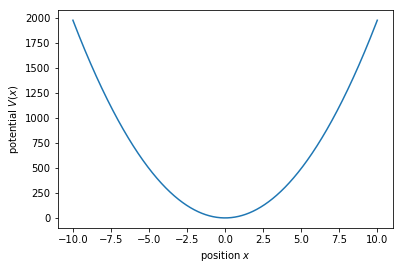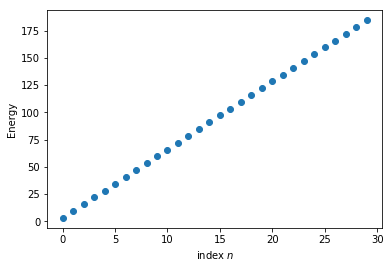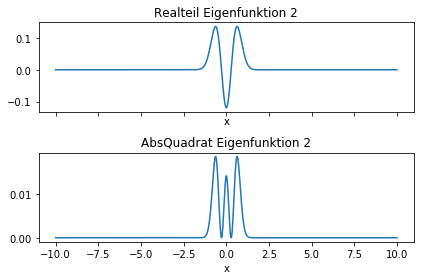Some simple quantum mechanics in python
Numerics in python
This notebook stems from the undergrad lectures at Heidelberg University on quantum mechanics. As the questions on the topic keep coming back, I thought to share it here.
In this notebook we discuss a bit the basics of numerical methods and plotting in python. python as the standard language. A nice tutorial is this a A byte of Python. Importantly, we will not reinvent the wheel, but use some standard libraries for scientific programming. They will be:
- The jupyter notebook, for simple interactive coding.
- Numpy for all kinds of numerical methods.
- Matplotlib for all kind of plotting
Quantum harmonical oscillator
We will work our way through quantum harmonic oscillator for which the potential is: $$ V(x) = \frac{m\omega^2}{2}x^2 $$
We would now like to plot it up. For that we will need to import some routines, which simplify this.
# import plotting and numerics
import matplotlib.pyplot as plt
import numpy as np
from numpy import linalg as LA
now let us plot the potential
#parameters of the harmonic potential
omega = 2*np.pi; m = 1;hbar = 1
# parameters of the grid
Ngrid = 1001; xmin = -10; xmax = 10;
xvec = np.linspace(xmin,xmax,Ngrid);#a vector spanning from -10 to 10 with 100 grid points
Vx = m*omega**2/2*xvec**2;
f, ax = plt.subplots()
ax.plot(xvec,Vx);
ax.set_xlabel('position $x$');
ax.set_ylabel('potential $V(x)$');

Numerical diagonalization
While the potential is nice to look at, we would actually like to use python to do some more powerful stuff than simple plots. One of them is the numerical diagonialization of the problem.
Kinetic energy
So we first have to build the matrix that represents the kinetic energy. For that to work we discretize the second order derivative as: $$ f''(x) = \frac{f(x-dx)+f(x+dx)-2f(x)}{dx^2} $$
#resolution of the grid
dx = np.diff(xvec).mean()
dia = -2*np.ones(Ngrid)
offdia = np.ones(Ngrid-1)
d2grid = np.mat(np.diag(dia,0) + np.diag(offdia,-1) + np.diag(offdia,1))/dx**2
#avoid strange things at the edge of the grid
d2grid[0,:]=0
d2grid[Ngrid-1,:]=0
Ekin = -hbar**2/(2*m)*d2grid
Ekin
matrix([[ 0., 0., 0., ..., 0., 0., 0.],
[-1250., 2500., -1250., ..., 0., 0., 0.],
[ 0., -1250., 2500., ..., 0., 0., 0.],
...,
[ 0., 0., 0., ..., 2500., -1250., 0.],
[ 0., 0., 0., ..., -1250., 2500., -1250.],
[ 0., 0., 0., ..., 0., 0., 0.]])
Potential energy
This one is just a diagonal matrix that we have to initialize properly.
#potential energy as matrix
Epot = np.mat(np.diag(Vx,0))
Epot
matrix([[1973.92088022, 0. , 0. , ..., 0. ,
0. , 0. ],
[ 0. , 1966.03309238, 0. , ..., 0. ,
0. , 0. ],
[ 0. , 0. , 1958.16109591, ..., 0. ,
0. , 0. ],
...,
[ 0. , 0. , 0. , ..., 1958.16109591,
0. , 0. ],
[ 0. , 0. , 0. , ..., 0. ,
1966.03309238, 0. ],
[ 0. , 0. , 0. , ..., 0. ,
0. , 1973.92088022]])
Diagonalization
We can now put them together as:
#%% combine to Hamiltonian, diagonalize and plot the lowest 30 energy eigenvalues
H = Ekin + Epot
# diagonalization
w, v = LA.eig(H)
# sort it such that things look nice later
sortinds = np.argsort(w)
EigVecs = v[:,sortinds]
EigVals = w[sortinds]
Time to plot up the eigenvalues.
f, ax = plt.subplots()
ax.plot(EigVals[0:30],'o')
ax.set_ylabel('Energy')
ax.set_xlabel('index $n$')
Text(0.5, 0, 'index $n$')

and now some eigenfunctions
n=2
fig, (ax1,ax2) = plt.subplots(2,1, sharex=True)
ax1.plot(xvec,np.real(EigVecs[:,n]))
ax1.set(title='Realteil Eigenfunktion %d'%(n),xlabel='x')
ax2.plot(xvec,np.power(np.abs(EigVecs[:,n]),2))
ax2.set(title='AbsQuadrat Eigenfunktion %d'%(n),xlabel='x')
fig.tight_layout()

Feel free to extend this further as you wish at some later stage.